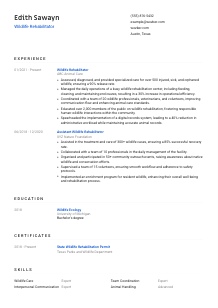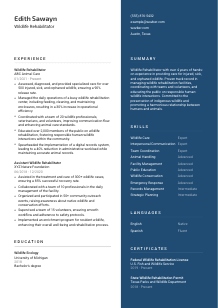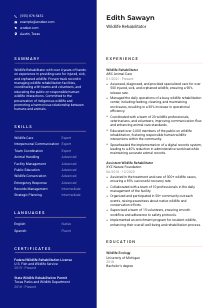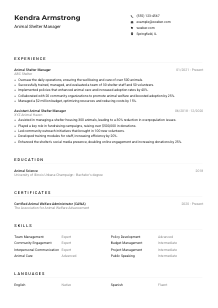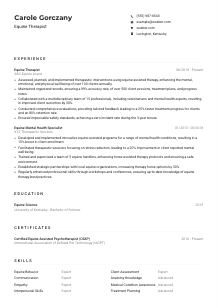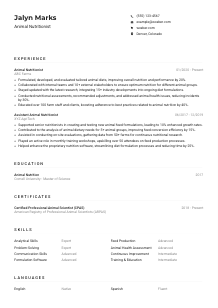Wildlife Rehabilitator Resume Example
Nurturing lost critters, but your resume seems untamed? Dive into this Wildlife Rehabilitator resume example, shaped with Wozber free resume builder. See how you can blend your rescue expertise with job criteria, guiding your wildlife career back to its natural habitat, professionally and compassionately!
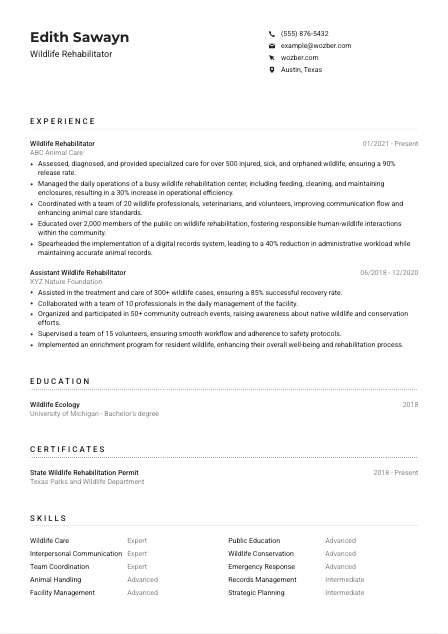
How to write a Wildlife Rehabilitator resume?
Eager to champion the cause of wildlife care but struggling to mirror your passion on paper? Dive into the essence of crafting a Wildlife Rehabilitator resume that not only showcases your dedication but is also finely tuned to the specific heartbeat of your dream role. With Wozber's free resume builder at your side, embarking on a journey to articulate your professional saga in an ATS-compliant manner is a breeze.
Let's sculpt a resume narrative that aligns your rescue endeavors with the intricacies of the job, integrating ATS-friendly resume templates and ATS optimization tools to ensure your application stands out in the wild terrain of job hunting.
Personal Details
Your journey begins with the Personal Details section, a concise yet potent showcase of your professional identity. Here's how to ensure that this segment harmoniously aligns with your aspirations to become a Wildlife Rehabilitator, making a compelling first impression.
1. Identify Yourself
Consider your name the beacon that guides hiring managers through your resume. Opt for a legible font and size that stands out, yet maintains a professional aura.
2. Reflect Your Role
Instantly bridge your qualifications with the job title "Wildlife Rehabilitator" stated beneath your name. This helps in positioning you as the right fit from the get-go.
3. Contact Essentials
Ensure your contact information is perfectly pruned - a reliable phone number and a professional email address should suffice, cutting out any room for error.
4. Root in the Right Location
Signal your availability in "Austin, Texas," as requested in the job description. This detail can be the cherry on top, affirming your logistical fit for the role.
5. Online Footprint
If applicable, sharing your professional website or a LinkedIn profile can add depth to your presentation, making you more reachable and verifiable to prospective employers.
Takeaway
Envision the Personal Details section as your resume's doorway, inviting the hiring manager into your professional world. Keep it aligned, precise, and reflective of the Wildlife Rehabilitator role you aspire to secure.





Experience
The Experience section is where your professional journey comes to life, telling tales of your contributions and competencies. Tailoring this segment for the Wildlife Rehabilitator position means demonstrating your direct impact on wildlife care and rehabilitation. Let's navigate through the process.
- Assessed, diagnosed, and provided specialized care for over 500 injured, sick, and orphaned wildlife, ensuring a 90% release rate.
- Managed the daily operations of a busy wildlife rehabilitation center, including feeding, cleaning, and maintaining enclosures, resulting in a 30% increase in operational efficiency.
- Coordinated with a team of 20 wildlife professionals, veterinarians, and volunteers, improving communication flow and enhancing animal care standards.
- Educated over 2,000 members of the public on wildlife rehabilitation, fostering responsible human‑wildlife interactions within the community.
- Spearheaded the implementation of a digital records system, leading to a 40% reduction in administrative workload while maintaining accurate animal records.
- Assisted in the treatment and care of 300+ wildlife cases, ensuring a 85% successful recovery rate.
- Collaborated with a team of 10 professionals in the daily management of the facility.
- Organized and participated in 50+ community outreach events, raising awareness about native wildlife and conservation efforts.
- Supervised a team of 15 volunteers, ensuring smooth workflow and adherence to safety protocols.
- Implemented an enrichment program for resident wildlife, enhancing their overall well‑being and rehabilitation process.
1. Untangle Job Requirements
Begin by dissecting the job description, identifying key experiences such as "Provided specialized care for over 500 injured, sick, and orphaned wildlife".
2. Build with Roles and Impact
List your previous positions in reverse-chronological order, focusing on roles and accomplishments that resonate with wildlife rehabilitation, like managing rehabilitation center operations or coordinating with wildlife professionals.
3. Narrate Your Impact
Quantify your contributions where possible. Statements like "ensuring a 90% release rate" and "resulting in a 30% increase in operational efficiency" provide a tangible measure of your success.
4. Highlight Relevancy
Stay focused on pertinent experiences. Your ability to educate the public and implement a digital records system directly ties back to the responsibilities of a Wildlife Rehabilitator.
5. Relevant Achievements
Cherry-pick achievements that mirror the job's needs, like "Coordinated with a team of 20 wildlife professionals" and "Educated over 2,000 members of the public," to underscore your alignment with the role's requirements.
Takeaway
Shape your Experience section to reflect your prowess in wildlife rehabilitation, making each bullet point a testament to your capability and fit for the position. This is your arena to prove your mettle and passion for the role.
Education
Your Education segment lays the foundational stones of your expertise in wildlife care. Tailoring this to meet specific job requirements, while showcasing your engagement with the field, adds an invaluable layer to your candidacy as a Wildlife Rehabilitator.
1. Match Educational Requisites
Highlight your "Bachelor's degree in Wildlife Ecology" prominently, ensuring it aligns seamlessly with the job's educational requirements.
2. Presentation Matters
Present your educational background succinctly, including the degree, institution, and year of completion, maintaining clarity and conciseness.
3. Tailoring Degree Details
Capitalize on your degree's relevance to the position, affirming your foundation in subjects crucial for a Wildlife Rehabilitator.
4. Coursework and Projects
For roles demanding a specific skill set or knowledge, include relevant courses or projects. In your case, the comprehensive degree supersedes the need, but it's a good practice to remember.
5. Additional Honors
If your academic journey includes notable honors or extracurricular involvement in wildlife conservation, don't shy away from showcasing these achievements.
Takeaway
Ensure your educational qualifications not only align with the job's requirements but also highlight the depth of your commitment to wildlife care. This section is a canvas to showcase the academic roots of your passion.
Certificates
In the world of Wildlife Rehabilitation, specific certification can be a mark of excellence and dedication. Here, we'll explore how to spotlight your certifications to underscore your readiness and distinguish your application.
1. Essential Certifications
Start by listing pivotal certifications, like your "State Wildlife Rehabilitation Permit" and "Federal Wildlife Rehabilitation License," directly echoing the requirements.
2. Selection Criterion
Prioritize including certifications that deeply resonate with the role's demand, ensuring they underline your competence and commitment to the field of wildlife care.
3. Validity and Recency
Mention the acquisition and, if relevant, the expiration dates of your certifications to testify to your continuous engagement and up-to-date expertise.
4. Ever-Evolving
Wildlife rehabilitation is a domain that grows and changes. Stay on the pulse by regularly updating your certifications and seeking new learning opportunities.
Takeaway
Your certifications are a loud testament to your specialization and ongoing commitment to excellence in wildlife rehabilitation. Let them shine brightly on your resume, demonstrating your preparedness and zeal for the role.
Skills
As a Wildlife Rehabilitator, your skills are your tools of transformation, your means to make a tangible impact in the lives of wildlife. Let's delve into mapping your skills to the job requirements, ensuring that your resume beams with capability and alignment.
1. Extract Key Skills
Scrutinize the job description to identify demanded skills such as "Wildlife Care," "Interpersonal Communication," and "Team Coordination," and align your listed skills accordingly.
2. Showcase Relevant Expertise
Prioritize your skills list by relevance, positioning your strongest and most pertinent skills, like "Wildlife Care" and "Facility Management," front and center.
3. A Harmonized Skill Section
Balance is key. Include a mix of hard and soft skills to paint a comprehensive picture of your capabilities, enriching the resume's narrative with a spectrum of your professional versatility.
Takeaway
Your Skills section is a brief yet impactful anthology of your competencies, crafted to echo the requirements of the Wildlife Rehabilitator role you're eyeing. Let it not just list but testify to your affinity and capability for the position.
Languages
In the realm of Wildlife Rehabilitation, communication extends beyond human interaction, touching the lives of the beings you aim to protect. However, articulating your linguistic capabilities can further enhance your resume, especially when the role demands proficiency in specific languages.
1. Job Language Requirements
Acknowledge the language requirements from the job description, such as proficiency in "English for business communication," and make sure it's prominently listed.
2. Ranking Languages
Position the required language at the pinnacle of your list and follow it with any additional languages, showcasing your linguistic diversity.
3. Array of Languages
Even if not explicitly required, other languages you speak can highlight your versatility and ability to engage with diverse communities or international (volunteers) teams.
4. Honesty in Proficiency
Be transparent about your level of proficiency in each language, using terms like "Native" or "Fluent" to give a clear picture of your linguistic capabilities.
5. Contextual Importance
Reflect on the broader role and its requirements when listing languages. In cases where the role may have a wider geographical impact, showcasing additional language skills could be particularly advantageous.
Takeaway
Your multilingual abilities are not only a testament to your communication skills but also to your potential to bridge communities. Flaunt your languages confidently, treating them as assets in your pursuit of being an exceptional Wildlife Rehabilitator.
Summary
Mastering your resume's Summary section is akin to perfecting a captivating opening scene. It sets the stage for your narrative, compelling the hiring manager to delve deeper. Let's fine-tune your summary to embody the essence of a Wildlife Rehabilitator.
1. Essence of Your Journey
Commence with a snapshot of your profession and years of involvement, establishing a solid base for your expertise as a Wildlife Rehabilitator.
2. Infuse with Key Highlights
Meld your skill set and career milestones into a potent brew, highlighting notable achievements like "a 90% release rate" and involvement in public education on wildlife.
3. Conciseness is Key
Craft your summary with precision, packing it with compelling details within a brief, impactful narrative that encapsulates your passion and aptitude for the role.
4. Your Professional Promise
View your summary as a pledge of the value you bring, weaving your skills, experience, and dedication into a narrative that promises exceptional contributions to wildlife rehabilitation.
Takeaway
Your Summary is the prelude to your professional story. Tailor it to speak directly to the Wildlife Rehabilitator role, mirroring the job's essence and demonstrating your unparalleled fit for the position. Let it be a beacon that guides the hiring manager through the depth of your dedication and competence.
Launching Your Wildlife Rehabilitator Journey
Congratulations on completing this guided tour through crafting an ATS-compliant resume tailored for a Wildlife Rehabilitator position. Armed with the insights provided, coupled with the robust features of Wozber's free resume builder, including ATS-friendly resume templates and an ATS resume scanner, you're now fully equipped to embark on a rewarding voyage in wildlife rehabilitation. Remember, your resume is more than a document; it's a testament to your passion and commitment to wildlife care.
Let it be your launchpad to a fulfilling career, advocating for those who cannot speak for themselves. The natural world awaits your expertise and compassion.

- Bachelor's degree in Biology, Wildlife Ecology, or a related field.
- Minimum of 2 years of experience in wildlife rehabilitation or a closely related field.
- Valid state and/or federal permits for wildlife rehabilitation, if applicable.
- Demonstrated knowledge of indigenous wildlife and their specific care requirements.
- Strong interpersonal and communication skills to work with volunteers, the public, and local authorities.
- Must be skilled in English for business communication.
- Must be located in Austin, Texas.
- Assess, diagnose, and provide appropriate care and treatment for injured, sick, or orphaned wildlife.
- Manage the daily operations of the rehabilitation facility, including feeding, cleaning, and maintaining enclosures.
- Coordinate with other wildlife professionals, veterinarians, and volunteers to ensure the best care for the animals.
- Educate the public on wildlife rehabilitation and promote responsible human-wildlife interactions.
- Maintain accurate records and reports on all animals admitted, treated, or released.





